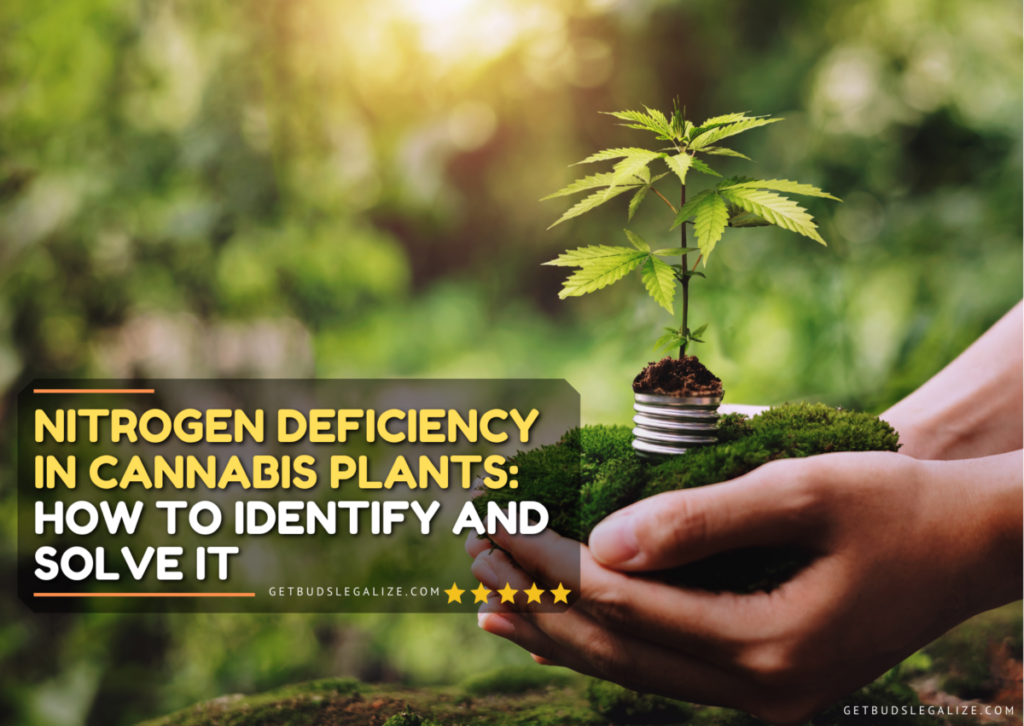Nitrogen Deficiency in Cannabis: How to Identify and Solve It
Nitrogen is one of the most important nutrients for cannabis growth. It is essential for many processes, such as photosynthesis, chlorophyll production, protein synthesis, and growth. Without enough nitrogen, cannabis plants will suffer from stunted growth, pale or yellow leaves, weak stems, and reduced yields.
However, too much nitrogen can also be harmful to cannabis plants. It can cause nutrient burn, leaf curling, dark green leaves, reduced bud development, and lower potency. Therefore, it is important to find the right balance of nitrogen for your cannabis plants.
How to Tell the Difference Between Nitrogen Deficiency and Toxicity in Cannabis?
Nitrogen deficiency and toxicity are two common problems that can affect cannabis plants. Nitrogen deficiency occurs when the plant does not get enough nitrogen from the soil or fertilizer, while nitrogen toxicity occurs when the plant gets too much nitrogen. Both conditions can cause yellowing of the leaves, but there are some differences that can help you tell them apart.
HOW TO IDENTIFY NITROGEN DEFICIENCY IN CANNABIS
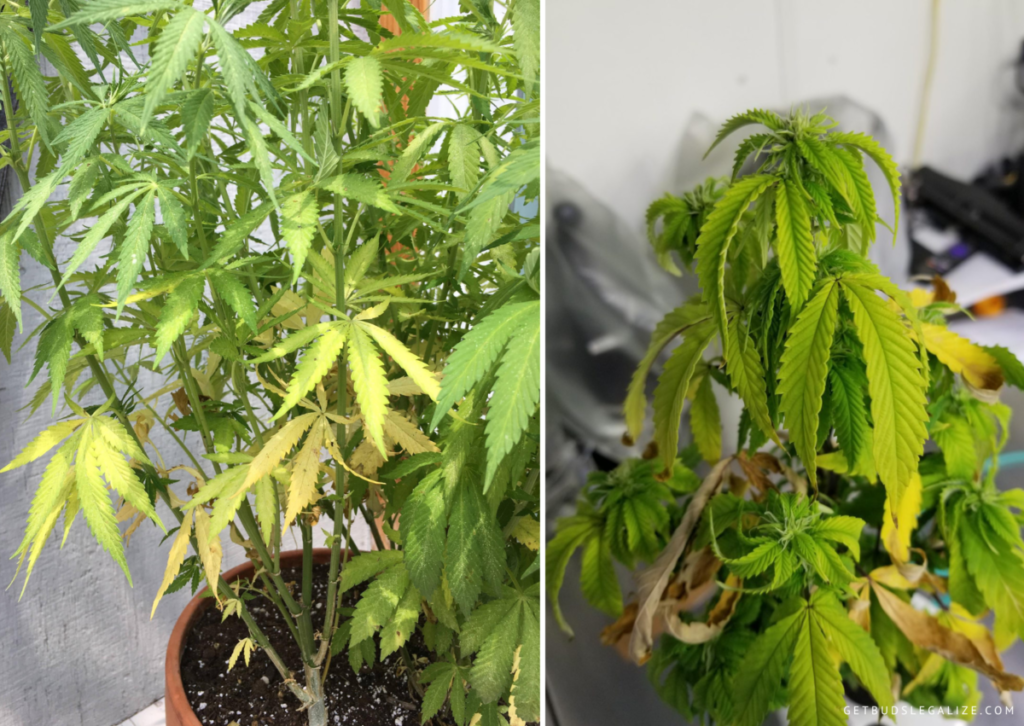
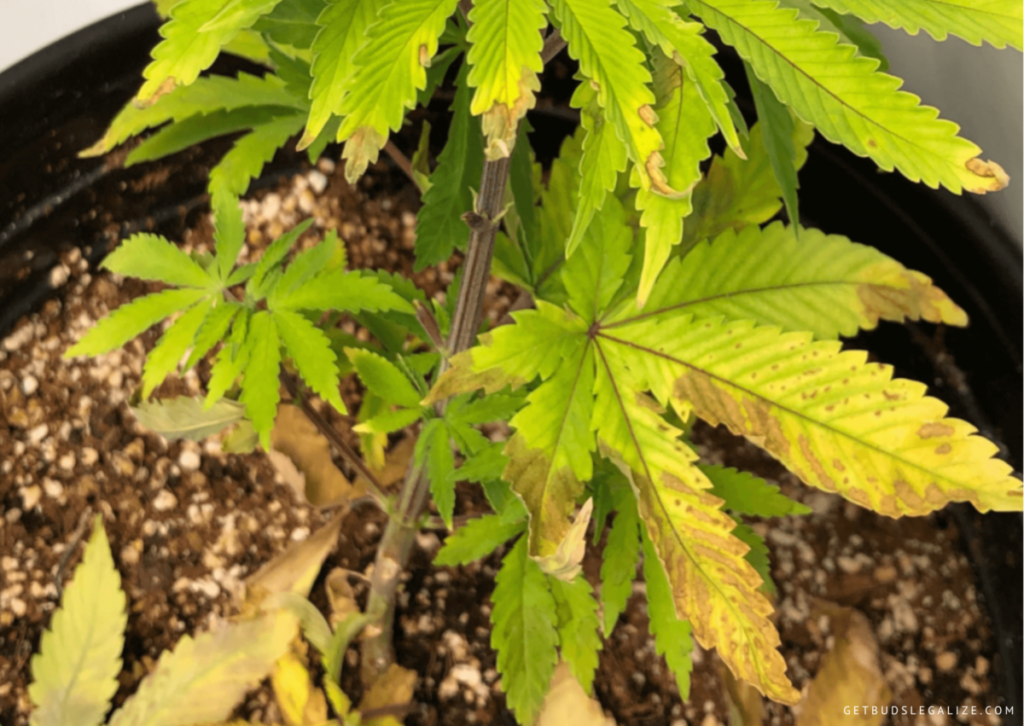
Nitrogen deficiency usually affects the older leaves at the bottom of the plant first. This is because nitrogen is a mobile nutrient that can move from older leaves to newer ones when there is a shortage. The affected leaves will turn yellow or lime-green and eventually wilt and die.
If left untreated, nitrogen deficiency will spread to the rest of the plant and affect its overall health and productivity. The plant will look pale and weak and have slow growth. The buds will also be smaller and less potent.
Symptoms of Nitrogen Deficiency in Cannabis Plants
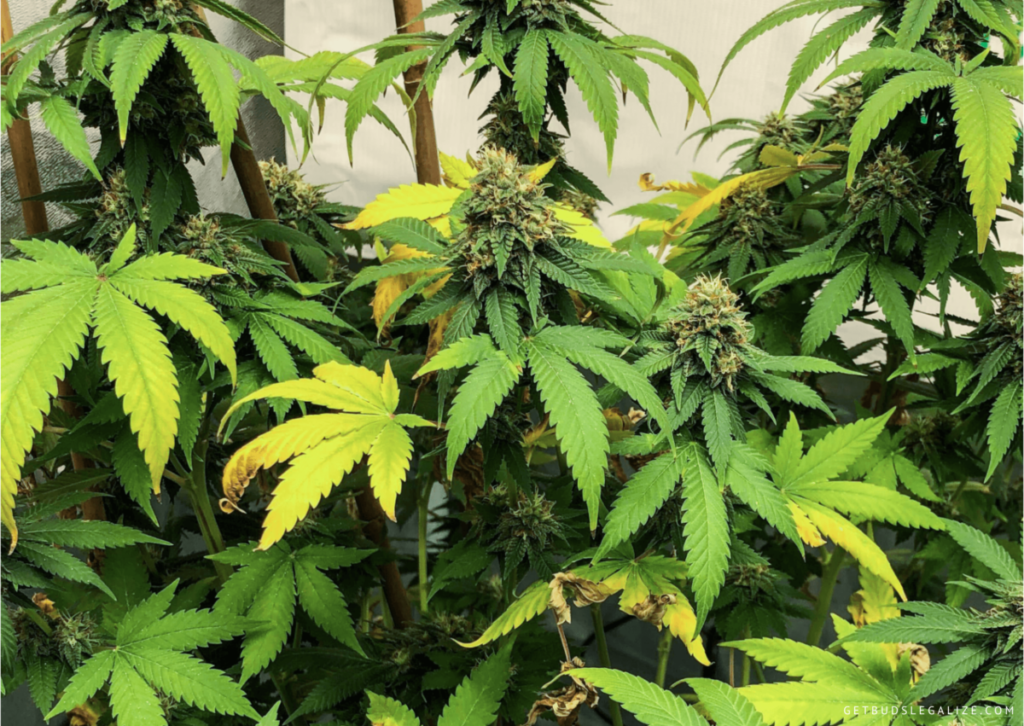
The most common symptom of nitrogen deficiency in cannabis plants is the yellowing of the lower leaves. This happens because nitrogen is a mobile nutrient that can move from older parts of the plant to newer ones when there is a shortage. As a result, the lower leaves lose their green color and become pale or lime-colored.
Other symptoms of nitrogen deficiency in cannabis plants include:
- Drooping or curling of the lower leaves
- Brown spots or edges on the lower leaves
- Drying or falling off of the lower leaves
- Reduced growth rate and height
- Thin stems and branches
- Small buds with low potency
What Causes Nitrogen Deficiency in Plants?
- Low-quality or depleted soil: If you are growing your cannabis plants in soil that is poor in organic matter or has been used for multiple cycles without replenishment, it may not have enough nitrogen available for your plants.
- Incorrect pH level: The pH level of your growing medium affects the ability of your plants to absorb nutrients from it. If the pH is too high or too low, it can lock out nitrogen and other essential elements from your plants’ roots.
- Overwatering: Watering your plants too frequently or too much can cause root rot and oxygen deprivation, which can impair nutrient uptake and lead to nitrogen deficiency.
- Underfeeding: If you are not providing enough fertilizer or nutrients to your plants during the vegetative stage, they may not get enough nitrogen to support their growth and development.
- Overfeeding: On the other hand, if you are giving too much fertilizer or nutrients to your plants during the flowering stage, they may experience a nutrient burn and toxicity, which can also cause nitrogen deficiency by damaging their roots and leaves.
How to Treat Nitrogen Deficiency in Plants
The best way to solve nitrogen deficiency in marijuana plants depends on the severity of the problem and the stage of growth. Here are some possible solutions:
- Use a nitrogen-rich fertilizer: Your plant needs plenty of nitrogen during the vegetative stage. You can use a water-soluble fertilizer that contains high levels of nitrogen (such as 20-10-10) and apply it according to the instructions on the label. You can also use an organic fertilizer that contains natural sources of nitrogen (such as blood meal, fish meal, or bat guano) and mix it with your soil before planting or top-dress it around your plant’s base every few weeks.
- Add nitrogen supplements: Check if your fertilizer provides your plant with an adequate amount of nitrogen. If not, you can add some supplements that contain additional forms of nitrogen (such as urea, ammonium nitrate, or calcium nitrate) and dissolve them in water before feeding your plant. However, be careful not to overdo it as too much nitrogen can cause nutrient burn and toxicity.
- Adjust soil pH: Your marijuana plant’s ability to absorb nitrogen depends on the pH level of the soil. Ideally, you want a pH range between 6.0 and 7.0 for soil-grown cannabis plants (5.5 and 6.5 for hydroponics). You can use a pH meter or test kit to measure your soil’s pH level and adjust it accordingly using lime (to raise pH) or sulfur (to lower pH).
- Use a foliar spray: A foliar spray is a solution that you spray directly onto your plant’s leaves instead of watering its roots. This can help deliver nutrients faster and more efficiently than through soil absorption. You can use a commercial foliar spray that contains micronutrients (such as iron) along with some diluted fertilizer (such as 10% strength) once every two weeks during vegetative growth.
- Stop overwatering: Overwatering can cause many problems for your cannabis plants besides nutrient deficiencies. To avoid overwatering, you should check your soil’s moisture level by inserting your finger into it up to knuckle depth before watering again.
ILGM Fertilizer

- From seedling to harvest, give your plants everything they need.
- Enough for feeding at least 5 plants.
- Discounted Package Deal
- Works well in soil, hydroponics, and other growing mediums.
- The best way to treat your plants
ILGM Plant Protector

- Protect your cannabis from diseases and harmful pests.
- Contains three 20 ml bottles.
- Enough supplies to protect 20 plants.
- It can be used in soil, hydroponic, and all other growing mediums.
How to Prevent Nitrogen Deficiency in Cannabis
Here are some tips on how to prevent nitrogen deficiency in marijuana plants:
- Choose a high-quality soil or growing medium that contains organic matter and has good drainage and aeration. Organic matter can provide a natural source of nitrogen for your plants through decomposition.
- Water your plants properly according to their needs. Avoid overwatering or underwatering your plants as this can affect their nutrient uptake and cause root problems. Check the moisture level of your soil or growing medium regularly and adjust accordingly.
- Maintain a proper pH level for your soil or growing medium. The ideal pH range for cannabis plants is 6.0-7.0 for soil and 5.5-6.5 for hydroponics. Use a pH meter or test kit to measure the pH of your water and soil or growing medium before feeding your plants. If needed, use pH up or down products to adjust the pH levels.
- Feed your plants with a balanced fertilizer that contains nitrogen and other essential nutrients. Follow the instructions on the label and avoid overfeeding or underfeeding your plants. In general, cannabis plants need more nitrogen during the vegetative stage than during the flowering stage.
- If you notice signs of nitrogen deficiency in your plants, such as the yellowing of older leaves at the bottom of the plant that spreads upward over time (mobile nutrient), you can apply a foliar spray with a nitrogen-rich fertilizer to quickly boost their nitrogen levels. Alternatively, you can add some organic amendments to your soil or growing medium that are high in nitrogen (such as blood meal) (immobile nutrient), but be careful not to overdo it as this can cause a nutrient burn.
HOW TO IDENTIFY NITROGEN TOXICITY
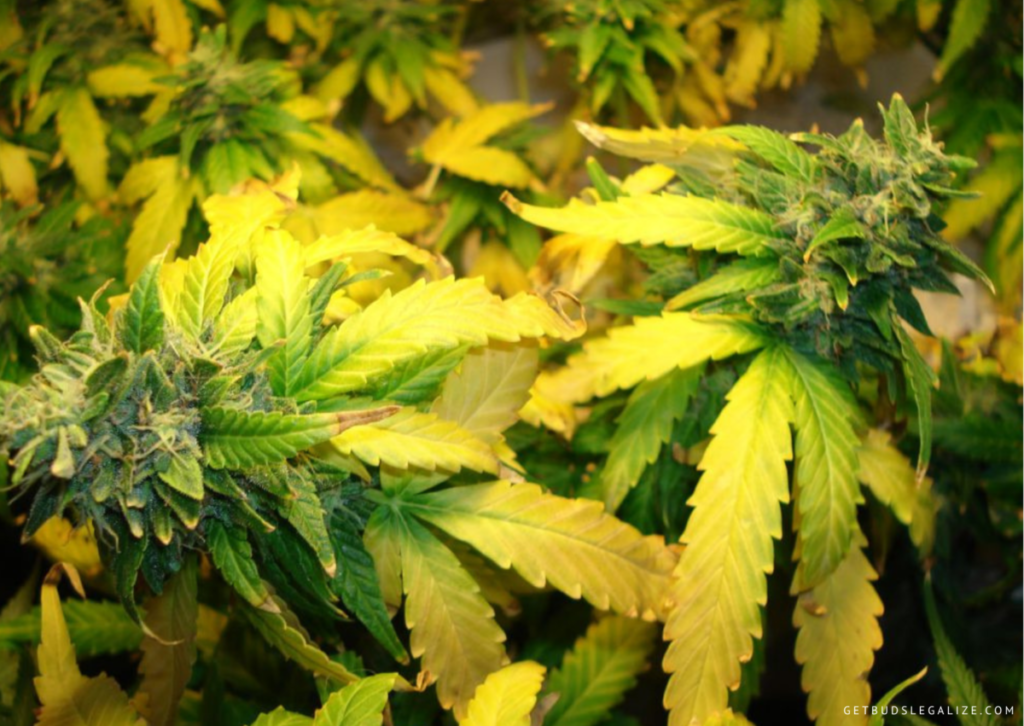
Nitrogen is an essential element for plant growth and development, but too much or too little can cause problems.
Nitrogen toxicity occurs when the plant absorbs more nitrogen than it can use, resulting in an accumulation of excess nitrogen in the plant tissues. This can cause various symptoms, such as:
- Dark green leaves that are shiny and glossy
- Leaves that droop and curl downwards, forming a claw-like shape
- Yellowing and browning of leaf tips and edges (nutrient burn)
- Weak stems that are prone to breaking
- Slow growth and reduced bud development
- Reduced potency and flavor of buds
What Causes of Nitrogen Toxicity
Nitrogen toxicity can have several causes, but the most common one is overfeeding. Many growers tend to give their plants too much nitrogen-rich fertilizer, especially during the vegetative stage when they want to boost their growth. However, this can backfire and cause nitrogen toxicity, especially if the fertilizer is not diluted properly or applied too frequently.
Another possible cause of nitrogen toxicity is a buildup of nitrogen in the soil or growing medium. This can happen if the soil or medium is not flushed regularly with plain water or if it contains organic matter that decomposes and releases nitrogen. This can also occur if the pH level of the soil or medium is too high or too low, which affects the availability and uptake of nutrients by the plant roots.
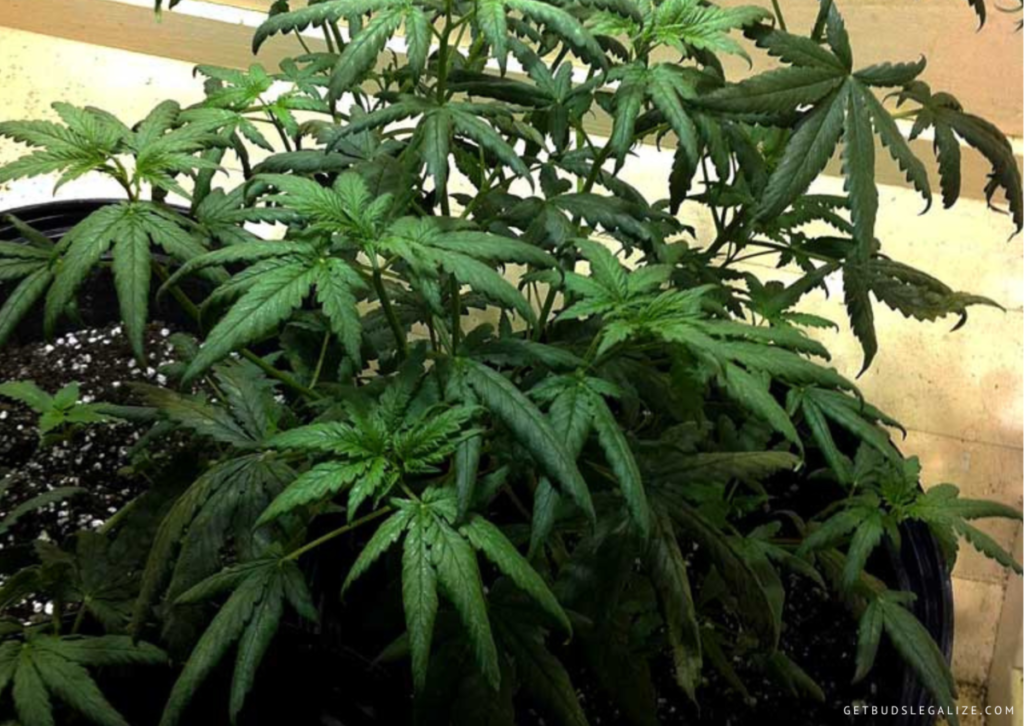
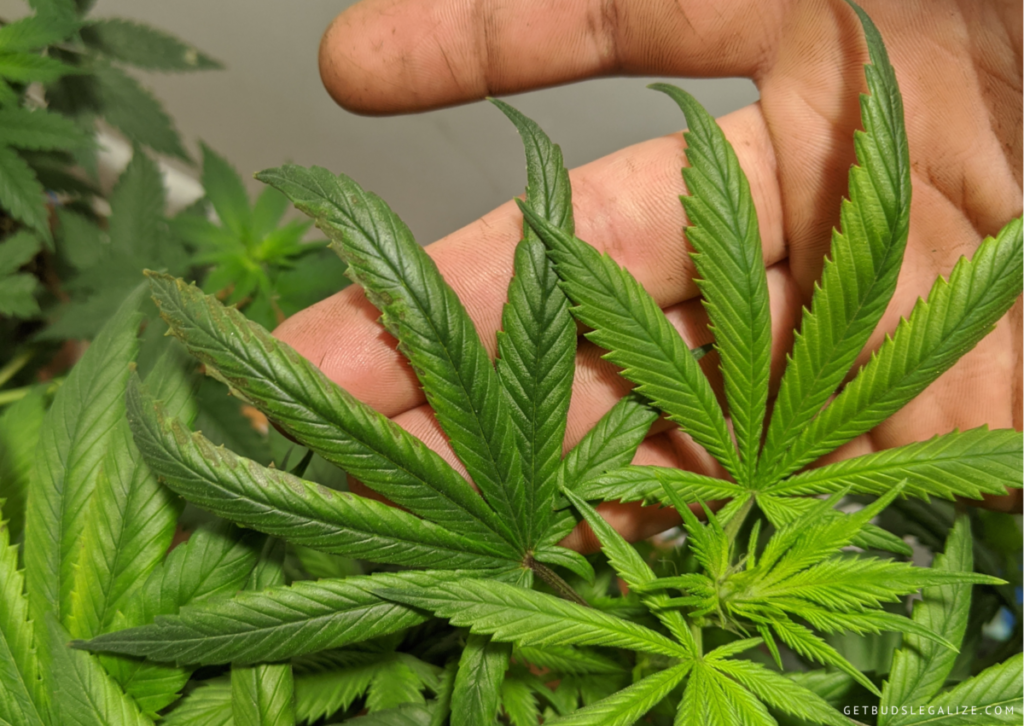
How to Fix Nitrogen Toxicity in Cannabis
- The first step to it is to stop feeding your plants any fertilizer that contains nitrogen. Instead, give them plain water with a balanced pH level (between 6.0 and 7.0 for soil and between 5.5 and 6.5 for hydroponics) until you see signs of improvement.
- You may also need to flush your soil or growing medium with plenty of water to wash away any excess nitrogen that has accumulated over time. This will help restore the balance of nutrients in your growing environment and prevent further problems.
- If your plants are severely affected by nitrogen toxicity, you may need to prune some of the damaged leaves to reduce stress on your plants and improve air circulation around them. However, be careful not to remove too many leaves at once, as this can shock your plants and slow down their recovery.
How to Prevent Nitrogen Toxicity in Cannabis
The best way to prevent it is to avoid overfeeding your plants with nitrogen-rich fertilizers. Follow the instructions on your fertilizer label carefully and adjust the dosage according to your plant’s needs and stage of growth.
Generally speaking, cannabis plants need more nitrogen during the vegetative stage than during the flowering stage. Therefore, you should switch to a lower-nitrogen fertilizer when you switch your light cycle from 18/6 (vegetative) to 12/12 (flowering). You can also use different types of fertilizers for each stage, such as:
- Vegetative stage: Use a complete fertilizer with a high ratio of nitrogen (N) compared to phosphorus (P) and potassium (K), such as 10-5-5 or 20-10-10.
- Flowering stage: Use a bloom fertilizer with a low ratio of nitrogen compared to phosphorus and potassium, such as 5-10-10 or 3-12-6.
Another way to prevent nitrogen toxicity is to monitor your soil or growing medium regularly for pH level, moisture level, temperature, and nutrient content. You can use various tools such as pH meters, moisture meters, thermometers, and nutrient testers to check these parameters and make adjustments accordingly.
You should also flush your soil or growing medium every few weeks with plain water to remove any salt buildup and refresh your nutrient solution. This will help maintain a healthy balance of nutrients in your growing environment and prevent nutrient lockout or deficiency.
Conclusion
If you suspect that your plants have either nitrogen deficiencies or toxicity or toxicity, you should test your soil for nitrogen content and adjust your fertilizer application accordingly. You can also use foliar sprays of diluted nitrogen fertilizer to correct mild cases of deficiency. However, be careful not to overdo it as this can cause more harm than good. Remember that moderation is key when it comes to nitrogen fertilization.
If you want to know more about common cannabis nutrient deficiencies we recommend following our complete guide [see more]
FAQ
Nitrogen deficiency in cannabis is a common problem for cannabis plants, especially during the flowering stage. Nitrogen is essential for plant growth and development, but it can be depleted by overwatering poor soil quality or excessive nutrient use. If left untreated, nitrogen deficiency can cause yellowing and wilting of leaves, stunted growth, and reduced yield.
Fortunately, cannabis plants can recover from nitrogen deficiency if the problem is identified and corrected early. The first step is to diagnose the cause of the deficiency and adjust the watering schedule, soil pH, or nutrient solution accordingly. The second step is to supplement the plants with a nitrogen-rich fertilizer or organic amendment such as blood meal or fish emulsion. The third step is to monitor the plants for signs of improvement or further issues.
Cannabis plants can bounce back from nitrogen deficiency if they are given proper care and attention. However, it is better to prevent this problem from occurring in the first place by following a balanced feeding schedule and using high-quality soil or growing medium.
The fastest way to fix nitrogen deficiency in cannabis is to apply a nitrogen-rich fertilizer to the soil or directly to the plant’s leaves. Some examples of nitrogen-rich fertilizers are urea, ammonium nitrate, blood meal, fish emulsion, and compost. The amount and frequency of application depend on the type and severity of the deficiency, as well as the plant’s needs.
Nitrogen deficiency is a condition that occurs when plants do not receive enough nitrogen from the soil or fertilizer. Nitrogen is an essential nutrient for plant growth and development, and it affects many aspects of plant physiology such as photosynthesis, chlorophyll synthesis, protein synthesis, and enzyme activity. Some of the early signs of nitrogen deficiency are:
- Yellowing or pale green color of the leaves, especially the older ones at the bottom of the plant.
- Reduced growth rate and stunted appearance of the plant.
- Thin and weak stems that may bend or break easily.
- Poor flowering and fruiting performance.
If left untreated, nitrogen deficiency can lead to reduced crop yield and quality. Therefore, it is important to monitor the nitrogen status of your plants regularly and apply appropriate fertilizers or organic amendments to correct any deficiency.
To fix it, you need to provide your plants with a source of nitrogen that they can absorb quickly and easily. Here are some possible solutions:
- Check the pH of your soil or water. If it is too high or too low, it can prevent your plants from absorbing nitrogen properly. The optimal pH range for cannabis is 6.0 to 7.0 for soil and 5.5 to 6.5 for hydroponics.
- Use a growth fertilizer that contains nitrogen, such as one with an NPK ratio of 20-10-10 or 16-8-8. Follow the instructions on the label and apply it every two weeks during the vegetative stage.
- Use an organic fertilizer or nitrate of soda that is rich in nitrogen. These products are natural and safe for your plants, but they may take longer to break down and release nitrogen into the soil.
- Increase nutrient levels with regular spring feedings. This will help your plants get enough nitrogen throughout their life cycle, especially during flowering when they need more phosphorus and potassium as well.
- Use liquid plant foods that contain nitrogen. These products are easy to apply and can be absorbed by your plants quickly through their leaves or roots. You can spray them on your plants once a week during flowering.
- Mulch the soil with organic matter such as compost or manure. This will help retain moisture and improve soil structure, as well as provide a slow-release source of nitrogen for your plants.
- Use a blood meal as a top dressing on your soil. A blood meal is an animal by-product that is high in nitrogen and can boost your plant’s growth and green color.
If you follow these steps, you should be able to fix nitrogen deficiency in your marijuana plants within a week or two. However, be careful not to overdo it with nitrogen, as this can cause other problems such as a nutrient burn.

